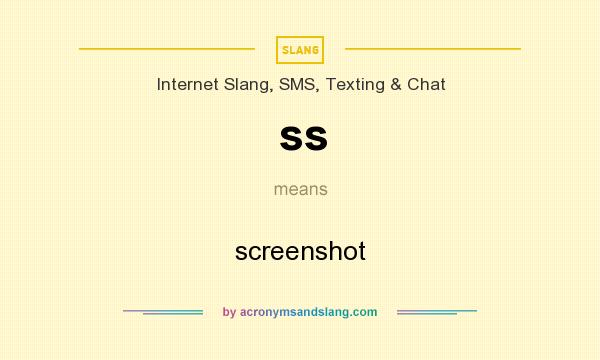In the ever-evolving digital vernacular of texting and online communication, acronyms and abbreviations reign supreme. They condense complex thoughts, convey urgency, and inject a dash of levity into our ephemeral digital exchanges. Among this pantheon of linguistic shortcuts, “ss” emerges as a particularly intriguing specimen. Its seemingly simple construction belies a multifaceted usage, demanding a nuanced understanding to decipher its intended meaning. Prepare to delve into the cryptic world of “ss,” where context is king and misinterpretation can lead to comical – or even disastrous – results.
The most prevalent interpretation of “ss” within the texting ecosystem is, unequivocally, “screenshot.” In an era dominated by visual communication, screenshots have become indispensable tools for capturing ephemeral content, preserving amusing exchanges, or documenting crucial information. Need to share a funny meme you stumbled upon? Snap a screenshot. Want to archive a particularly insightful comment from an online forum? Screenshot it. “Ss” serves as a succinct and efficient way to request this very action. It implores the recipient to capture what’s currently on their screen and share it posthaste. This is a common ask and something that most texters understand.
However, the linguistic landscape is rarely monolithic. “Ss,” like many abbreviations, possesses alternative denotations, contingent upon the specific context of the conversation. One such alternate meaning, albeit less common, is “so sorry.” When employed in this manner, “ss” functions as an abridged expression of remorse or apology. It conveys a sense of regret, though perhaps with a slightly more casual or informal tone than the full phrase. Its use might be favored when offering a quick apology for a minor transgression, such as a delayed response or a trivial oversight. It is not something that is common, but it does show up in some circles.
Navigating the treacherous waters of abbreviation ambiguity necessitates a keen awareness of the surrounding textual cues. A request for “ss” in a conversation centered around visual content strongly suggests the “screenshot” interpretation. Conversely, if the exchange involves apologies or expressions of regret, “so sorry” might be the more plausible candidate. Furthermore, consider the relationship dynamics between the interlocutors. Are they close friends accustomed to informal shorthand, or are they acquaintances engaging in more formal discourse? The level of familiarity can significantly influence the likelihood of abbreviated communication.
Beyond its primary interpretations, “ss” can also manifest as a contextual cipher, its meaning derived solely from the immediate environment of the message. In certain specialized online communities or gaming circles, “ss” might represent a term or concept specific to that particular niche. For example, in the realm of online gaming, “ss” could potentially signify “screen share,” a request for another player to broadcast their gameplay. Unearthing these esoteric meanings requires familiarity with the relevant subculture and a willingness to engage in contextual deduction. It is very specific and very unusual, but it is important to mention.
Furthermore, it is crucial to acknowledge the potential for misinterpretation and the ensuing communication breakdowns that can arise from ambiguous abbreviations. Imagine requesting “ss” intending “screenshot,” only to have the recipient interpret it as “so sorry” and respond with an unsolicited apology. Such scenarios underscore the importance of clarity and, when necessary, explicit articulation. If there’s any doubt about the recipient’s understanding, it’s always prudent to err on the side of caution and spell out the intended meaning in full. This is good advice for any context.
To mitigate the risks of miscommunication, consider employing strategies to disambiguate your usage of “ss.” If requesting a screenshot, you might preface the abbreviation with a clarifying phrase such as “can you ss that?” or “send me an ss.” Similarly, if intending “so sorry,” you could append a brief explanation, such as “ss about the delay.” These subtle additions provide crucial context and reduce the likelihood of unintended interpretations.
The proliferation of digital communication has undeniably spawned a unique linguistic landscape, one characterized by brevity, informality, and a constant evolution of language. “Ss,” in its various guises, serves as a microcosm of this dynamic process. Understanding its diverse meanings and the contextual factors that govern its interpretation is essential for navigating the complexities of modern texting and online interaction. So, the next time you encounter “ss” in a text message, remember to pause, consider the context, and decipher its intended meaning before responding. The rewards of such mindful communication are well worth the effort.
Mastery of the digital dialect requires constant vigilance, a proactive approach to learning, and a willingness to adapt to the ever-shifting sands of online slang. Embrace the ambiguity, unravel the cryptic codes, and become a virtuoso of the texting vernacular. The world of “ss” and its fellow abbreviations awaits your exploration.









Leave a Comment